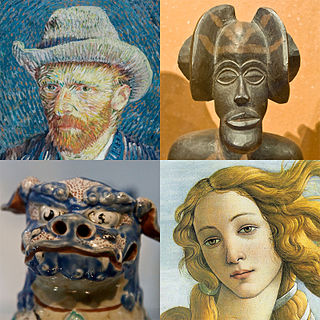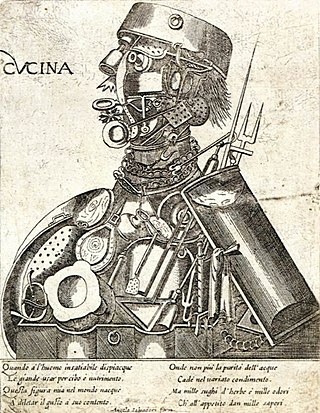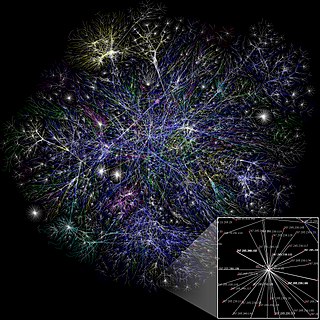Related Research Articles

Art is a diverse range of human activity, and resulting product, that involves creative or imaginative talent expressive of technical proficiency, beauty, emotional power, or conceptual ideas.

Cyberspace is a concept describing a widespread interconnected digital technology. "[The expression dates] from the first decade of the diffusion of the internet. It refers to the online world as a world 'apart,' as distinct from everyday reality. In cyberspace people can hide behind fake identities, as in the famous The New Yorker cartoon ..." The term entered popular culture from science fiction and the arts but is now used by technology strategists, security professionals, governments, military and industry leaders and entrepreneurs to describe the domain of the global technology environment, commonly defined as standing for the global network of interdependent information technology infrastructures, telecommunications networks and computer processing systems. Others consider cyberspace to be just a notional environment in which communication over computer networks occurs. The word became popular in the 1990s when the use of the Internet, networking, and digital communication were all growing dramatically; the term cyberspace was able to represent the many new ideas and phenomena that were emerging.

Gilles Louis René Deleuze was a French philosopher who, from the early 1950s until his death in 1995, wrote on philosophy, literature, film, and fine art. His most popular works were the two volumes of Capitalism and Schizophrenia: Anti-Oedipus (1972) and A Thousand Plateaus (1980), both co-written with psychoanalyst Félix Guattari. His metaphysical treatise Difference and Repetition (1968) is considered by many scholars to be his magnum opus.

Network topology is the arrangement of the elements of a communication network. Network topology can be used to define or describe the arrangement of various types of telecommunication networks, including command and control radio networks, industrial fieldbusses and computer networks.
The perennial philosophy, also referred to as perennialism and perennial wisdom, is a perspective in philosophy and spirituality that views religious traditions as sharing a single, metaphysical truth or origin from which all esoteric and exoteric knowledge and doctrine has grown.
Holism is the interdisciplinary idea that systems possess properties as wholes apart from the properties of their component parts. The concept of holism informs the methodology for a broad array of scientific fields and lifestyle practices. When applications of holism are said to reveal properties of a whole system beyond those of its parts, these qualities are referred to as emergent properties of that system. Holism in all contexts is opposed to reductionism which is the notion that systems containing parts contain no unique properties beyond those parts. Scientific proponents of holism consider the search for these emergent properties within systems the primary reason to incorporate it into scientific assumptions or perspectives.

Ananda Kentish Muthu Coomaraswamy was a Ceylonese metaphysician, historian and a philosopher of Indian art who was an early interpreter of Indian culture to the West. In particular, he is described as "the groundbreaking theorist who was largely responsible for introducing ancient Indian art to the West".
Communication design is a mixed discipline between design and information-development which is concerned with how media communicate with people. A communication design approach is not only concerned with developing the message in addition to the aesthetics in media, but also with creating new media channels to ensure the message reaches the target audience. Some designers use graphic design and communication design interchangeably due to overlapping skills.

An infinite regress is an infinite series of entities governed by a recursive principle that determines how each entity in the series depends on or is produced by its predecessor. In the epistemic regress, for example, a belief is justified because it is based on another belief that is justified. But this other belief is itself in need of one more justified belief for itself to be justified and so on. An infinite regress argument is an argument against a theory based on the fact that this theory leads to an infinite regress. For such an argument to be successful, it has to demonstrate not just that the theory in question entails an infinite regress but also that this regress is vicious. There are different ways in which a regress can be vicious. The most serious form of viciousness involves a contradiction in the form of metaphysical impossibility. Other forms occur when the infinite regress is responsible for the theory in question being implausible or for its failure to solve the problem it was formulated to solve. Traditionally, it was often assumed without much argument that each infinite regress is vicious but this assumption has been put into question in contemporary philosophy. While some philosophers have explicitly defended theories with infinite regresses, the more common strategy has been to reformulate the theory in question in a way that avoids the regress. One such strategy is foundationalism, which posits that there is a first element in the series from which all the other elements arise but which is not itself explained this way. Another way is coherentism, which is based on a holistic explanation that usually sees the entities in question not as a linear series but as an interconnected network. Infinite regress arguments have been made in various areas of philosophy. Famous examples include the cosmological argument, Bradley's regress and regress arguments in epistemology.
Holistic education is a movement in education that seeks to engage all aspects of the learner, including mind, body, and spirit. Its philosophy, which is also identified as holistic learning theory, is based on the premise that each person finds identity, meaning, and purpose in life through connections to their local community, to the natural world, and to humanitarian values such as compassion and peace.

Feminist art is a category of art associated with the late 1960s and 1970s feminist movement. Feminist art highlights the societal and political differences women experience in their lives. The hopeful gain from this form of art is to bring a positive and understanding change to the world, in hope to lead to equality or liberation. Media used range from traditional art forms such as painting to more unorthodox methods such as performance art, conceptual art, body art, craftivism, video, film, and fiber art. Feminist art has served as an innovative driving force towards expanding the definition of art through the incorporation of new media and a new perspective.
Telematic art is a descriptive of art projects using computer-mediated telecommunications networks as their medium. Telematic art challenges the traditional relationship between active viewing subjects and passive art objects by creating interactive, behavioural contexts for remote aesthetic encounters. Telematics was first coined by Simon Nora and Alain Minc in The Computerization of Society. Roy Ascott sees the telematic art form as the transformation of the viewer into an active participator of creating the artwork which remains in process throughout its duration. Ascott has been at the forefront of the theory and practice of telematic art since 1978 when he went online for the first time, organizing different collaborative online projects.
Art as Experience (1934) is John Dewey's major writing on aesthetics, originally delivered as the first William James Lecture at Harvard (1932). Dewey's aesthetics have been found useful in a number of disciplines, including new media.

ZERO1: The Art and Technology Network is a 501(c)(3) non-profit organization dedicated to connecting creative explorers from art, science, and technology to provoke new ideas that serve to shape a more resilient future.
A theory of art is intended to contrast with a definition of art. Traditionally, definitions are composed of necessary and sufficient conditions and a single counterexample overthrows such a definition. Theorizing about art, on the other hand, is analogous to a theory of a natural phenomenon like gravity. In fact, the intent behind a theory of art is to treat art as a natural phenomenon that should be investigated like any other. The question of whether one can speak of a theory of art without employing a concept of art is also discussed below.
MyCiTi bus stations host the MyCiTi bus lines that travel throughout the greater Cape Town area.

A colored pencil, coloured pencil, pencil crayon, map pencil, or coloured/colouring lead is an art medium constructed of a narrow, pigmented core encased in a wooden cylindrical case. Unlike graphite and charcoal pencils, colored pencils' cores are wax- or oil-based and contain varying proportions of pigments, additives, and binding agents. Water-soluble (watercolor) pencils and pastel pencils are also manufactured as well as colored cores for mechanical pencils.
New media studies is an academic discipline that explores the intersections of computing, science, the humanities, and the visual and performing arts. Janet Murray, a prominent researcher in the discipline, describes this intersection as "a single new medium of representation, the digital medium, formed by the braided interplay of technical invention and cultural expression at the end of the 20th century". The main factor in defining new media is the role the Internet plays; new media is effortlessly spread instantly. The category of new media is occupied by devices connected to the Internet, an example being a smartphone or tablet. Television and cinemas are commonly thought of as new media but are ruled out since the invention was before the time of the internet.

Holism and Evolution is a 1926 book by South African statesman Jan Smuts, in which he coined the word "holism", although Smuts' meaning differs from the modern concept of holism. Smuts defined holism as the "fundamental factor operative towards the creation of wholes in the universe."
Graciela Bustos is a multi-disciplined immigrant artist from Neiva, Colombia. She works with multiple mediums to convey the sense of light and color in its original form. She has had multiple exhibits and is in a group called the DIALOGUISTAS, a group consisting of three members that work in Detroit Michigan.
References
- ↑ "Michigan Tech arts faculty". Archived from the original on 6 June 2010. Retrieved 18 April 2017.
- ↑ "Holistic approach/Society of Layerists in Multi-Media shares philosophy, not medium". Highbeam. 1 June 2001. Archived from the original on 4 November 2012. Retrieved 18 April 2017.